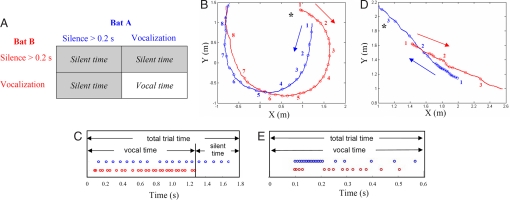Fig. 1.
Definitions of silent/vocal times and flight trajectories of paired bats in different flight configurations from selected trials. (A) Two possible behaviors: (1) Silence >0.2 s: the bat stopped vocalizing for more than 0.2 s; (2) Vocalization: the bat was vocalizing continuously, with intervals between 2 consecutive pulses always shorter than 0.2 s. Silent time is defined as when one or both bats went silent for over 0.2 s, and vocal time is defined as when both bats were vocalizing continuously. (B and D) Each circle represents an echolocation call and the asterisk marks the position of the target (tethered mealworm) in each trial. The number “1” beside each flight path represents the starting point and the time interval between successive numbers is 0.5 s. (B) Following flight for time indices “1–5” is 30–60° following flight and for time indices “6–8” is 0–30° following flight. The bat whose behavior is shown in red, stopped vocalizing after time index “7.” (D) Converging and diverging flights: before time index “2” is converging flight and after this point is diverging flight. The bat (data shown in blue) produced a series of short duration and short pulse interval calls (avoidance buzz) between time indices “1” and “2.” (C and E) The silent time, vocal time and total trial time. Each circle represents one vocalization and different colors represent different bats. Plots in B and C are based on one trial and plots in D and E are based on another trial.

